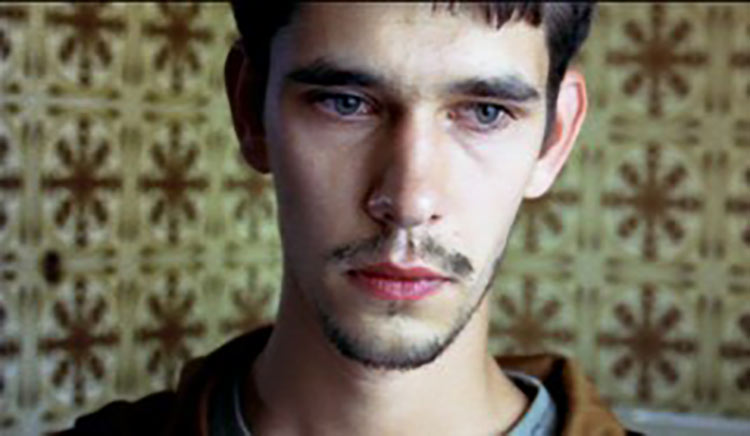 Turning insomnia to his advantage, director Alnoor Dewshi developed the concept for his astounding short 77 Beds whilst finding an alternative to counting sheep, “I got the idea from lying awake one night and trying to count back through all the beds I’d ever slept in, back to and including the bed I was born in; this was meant to send me to sleep, but I got stuck in my early 20s in a haze of uncountable beds that reflected my nomadic lifestyle at the time. It occurred to me that this was a perfectly good premise for a short.”
Turning insomnia to his advantage, director Alnoor Dewshi developed the concept for his astounding short 77 Beds whilst finding an alternative to counting sheep, “I got the idea from lying awake one night and trying to count back through all the beds I’d ever slept in, back to and including the bed I was born in; this was meant to send me to sleep, but I got stuck in my early 20s in a haze of uncountable beds that reflected my nomadic lifestyle at the time. It occurred to me that this was a perfectly good premise for a short.”
The premise developed into a 20 minute script and producer Chris Collins was able to raise money from the London Production Fund, secure free camera and lighting gear, post-production services and also bring Sherbet Productions on board on the back of feature films he was working on. However, they soon realised that even at minimum cast and crew rates there would be a substantial shortfall in the £16,000 budget. Dewshi was left with two choices: shoot 77 Beds on digital in friends and family’s houses with borrowed actors in a lo-fi style, or rewrite the script to match the available resources. As a director with several shorts already under his belt, Dewshi felt freed from the need to make a calling card short and instead concentrated on making 77 Beds as strong as possible. As the original script had a loose structure with a strong ending it was possible to cut the script in half and still deliver a short with the impact of the original story.
With script and budget issues solved, attention turned to finding two other key elements: the talent and the beds. Whilst out cycling, Dewshi passed ‘a strangely dressed young guy padding along, smiling at the clouds’ who was perfect for his lead. This strange cloud-starer was actor Ben Whishaw, with whom Dewshi had worked on the Hari Krishna-themed short Spiritual Rampage. He was offered the role on the spot. After expressing his admiration of Pasolini’s use of real people on screen and a desire to use a real girl for the young sister role, casting director Amanda Tabak prepared Dewshi for the months of searching this would require. Justine Georgiou proved her wrong by walking into the first casting session and workshopping scenes with Whishaw with such ease that they could easily have been a true siblings. The remainder of the cast fell into place with established actors Karl Johnson and Kate Fleetwood happy to give up their time for the single scenes they were needed for.
 The fortune of casting extended to the mass bed sourcing central to the premise of the film, with the crew tapping into a couple of squat networks complete with strangers willing to grant access to their inner sanctums, making public their sheet stains, used condoms, tampons, barely concealed pornography collections and love letters graffitied on the wall, all because they liked the idea of the film.
The fortune of casting extended to the mass bed sourcing central to the premise of the film, with the crew tapping into a couple of squat networks complete with strangers willing to grant access to their inner sanctums, making public their sheet stains, used condoms, tampons, barely concealed pornography collections and love letters graffitied on the wall, all because they liked the idea of the film.
The shoot progressed with little incident, the only slight worry being a Saturday morning lab report of slight fogging of the rushes. “We continued to shoot through the weekend and saw the rushes properly on Monday, at which time it became clear that minor fogging was more accurately major disaster; one-third of the rushes were marred by thick red flashes at the edge of the frame. The camera company, the lab and even Kodak met to examine the material, do tests, and scratch their heads in joint bewilderment. Usually errors have a distinctive signature, which identifies their cause as camera, magazine, stock or whatever, but this one stumped all the experts,” recalls Dewshi. Wisely the production had stumped up for insurance. Doubtful of being able to recapture the spontaneity of performance in re-shoots, the decision was made to attempt to repair the damaged footage, amid fears of dramatically altering the balance of some of the compositions, which extended to the very edge of the frame. In a process Dewshi describes as similar to watching a magician at work the film was corrected at Rushes Post Production in a TK suite without the need for reframing. The grader selectively desaturated the flashes, matched up the contrast and put the flesh tones back in. One scene was effectively re-lit so that the flashing fell into a shadow, with the rest of the room rejigged so it appeared naturalistic, even when the camera moved.
Used to reworking his films in post, a first cut of 77 Beds produced a heavily imbalanced film with a weighty tone. Editor Nicholas Chaudeurge rearranged the film’s chronology and shortened an over dominating scene while Dewshi wrote a new recollection monologue for the beds, producing a cut that not only works but also taps the emotions. Music from guitar band Pocket was found to fit the restless images, with John Bisset improvising along to his original to produce several remixed versions for various points in the film. Adding a 5.1 sound mix at Videosonics cemented the sensation of gliding between reality and the character’s imagination.
– Originally published in Showreel, Issue 6 (Winter 2004)



Link’s dead. The film is still here:
http://www.dewshi.com/films_by/77beds.html